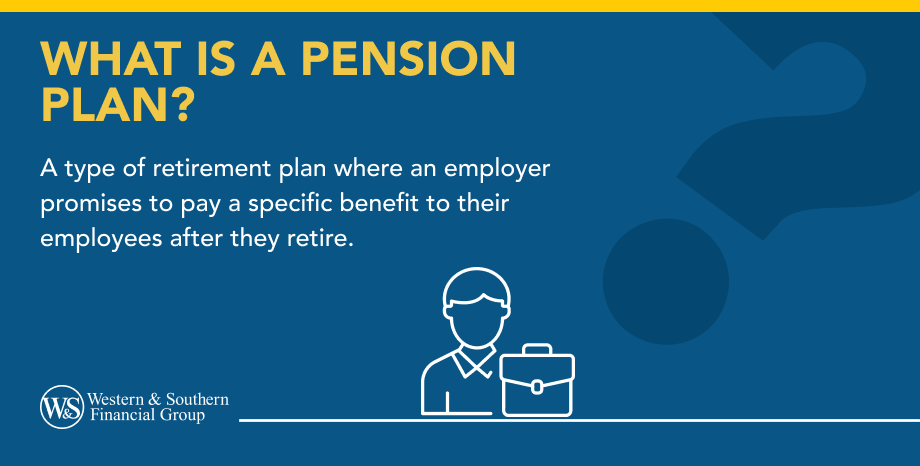

Table of Contents
Key Takeaways
- Pension plans are retirement accounts funded by employers that provide regular payments to employees in retirement.
- Payouts are typically based on a percentage of salary and years of service with the company.
- Common payout options include lump sum payments or annuities that provide guaranteed income streams.
- Vesting schedules dictate when employees are entitled to full pension benefits based on years of service.
- Pension plans are becoming less common, so understanding how they work is important if offered one.
After months of looking, you've just landed a new job — complete with an employee benefits package. After looking over the paperwork, you realize they offer both a 401(k) and pension plan. While you may be familiar with 401(k)s, you might not have a firm grasp on pension plans and how they work.
Definition of a Pension Plan
A pension plan is a type of retirement account that is funded by your employer on your behalf. Their investments enable you to receive payments at a later date — and these payments are meant to provide you a form of income in retirement. But before signing your name on the dotted line, take a little time to brush up on the fundamentals of pension plans. Learning more about these retirement plans could help you plan wisely for your golden years.
Pension Plans vs. 401(k)s
Pension Plans Are Defined Benefit Plans, Whereas 401(K)S Are Defined Contribution Plans.
With a defined benefit plan, your employer makes contributions to the plan with the promise that you would receive some money for your retirement. This money could come in the form of a lump sum, a specified amount each month or a combination of both. (Refer to your plan's description for more details.)
With a 401(k) plan, the employee is responsible for contributing to the retirement plan. Your employer may also offer a matching contribution, which comes as a percentage of your pay. A defined contribution plan comes with rules as to when and how you can take out the money you've contributed, as well as penalties for early withdrawal.
While Enrolled in a Defined Contribution Plan When Switching Jobs, Your Money Stays in the Plan.
When you leave your employer while enrolled in a defined contribution plan, you can either cash out the plan or roll over your account funds into a new individual retirement account (IRA) or 401(k). With a pension, the money typically stays in the plan. However, if the pension plan offers payment in the form of a lump sum, you may have the option to roll it over.
Fully Vested Interest
When you're fully vested in your employer's pension plan, you're entitled to receive 100 percent of the promised benefit under the plan. You generally need to put in a certain number of "hours of service" over a specified period before you become fully vested. Your employer will likely have a vesting plan schedule, which could take the form of a cliff vesting schedule or graded vesting schedule.
Cliff Vesting Schedule
Cliff vesting means you'll be fully vested after a specific number of years working for the employer. For example, your company could require you to stay for at least five years — or you'll lose 100 percent of your pension benefits.
Graded Vesting Schedule
With a graded vesting schedule (depending on your employer's vesting plan schedule), you could be entitled to 20 percent of your pension plan benefits after working two years and 100 percent (fully vested) after working six.
With some plans, you may collect "hours of service" immediately — while with others you may start accruing these hours of service after a year on the job. (One year of service typically equals 1,000 hours.)
Payouts from Pension Plans
The payout you receive from a pension plan is generally based on the following:
- Percentage of your pay x How many years you worked at your company
If you have a higher salary and have been with your employer for a longer period, you'll receive a higher payout.
Payouts Differ by Age
Depending on the plan, you could also receive different amounts of monthly payment depending on when you decide to start taking out contributions. Your pension plan determines at what age you're eligible to start receiving payments. For instance, you could be eligible under your employer's pension plan to start receiving payments at age 55. However, monthly payments at age 55 may be less than if you start receiving payments at age 60 — which could be even less than at age 65.
These monthly payments are promised from the time they begin throughout the rest of your life. Depending on the plan, you may be given the option of taking the money promised in the form of a lump sum or an annuity, which is a guaranteed stream of income for your golden years.
The Annuity Option
While what's offered depends on the pension plan, there are three different types of annuities:
- Single life annuity: While this gives you the largest monthly payment, the payments will stop after you die.
- Joint & survivor annuity: You'll receive payments during your lifetime, plus your spouse or a named beneficiary will receive payments after you die. This could be a good option if you're married and would like an annuity to help your surviving spouse with living expenses.
- Period certain annuity: As the name implies, you'll be guaranteed monthly payments for a certain period, such as five or 15 years. If you die before that period has elapsed, the remainder of your payments will go to your surviving beneficiary. So, if you're guaranteed an annuity for 20 years, and you die after receiving only 10 years of payments, your beneficiary will receive payments for the remaining 10 years.
The Bottom Line
Pension plans aren't as common these days — and will likely become rarer still. If your employer does offer a pension plan, it's important to explore what pension plans are, how they're different from other retirement plans and how they could fit into your savings goals for retirement.
















